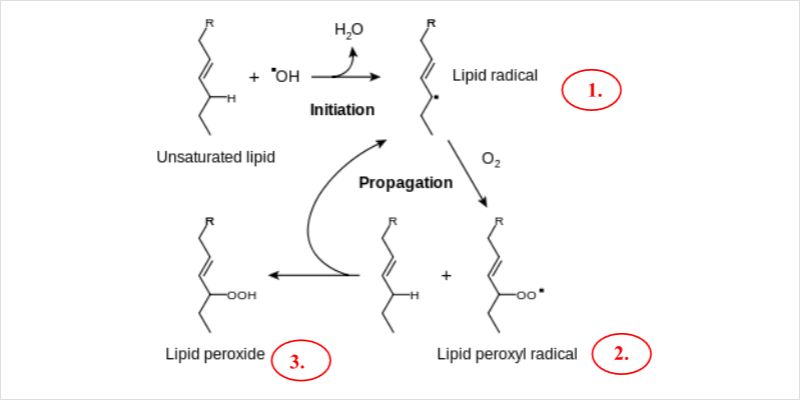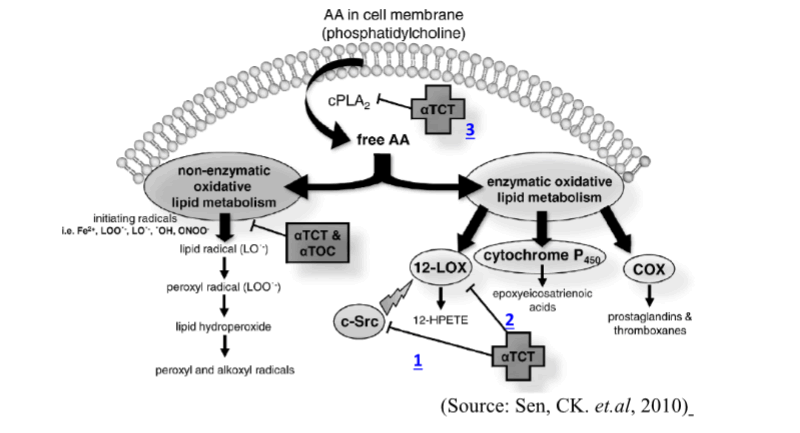
Cognitive and neurological health refers to the preservation of brain health and its overall function. Specifically, cognition includes the mental actions such as remembering, learning, judging or even problem-solving. In fact, one of the most common neurological problem that usually develops late in life is dementia or declining mental function, such as Alzheimer’s disease.
The greatest concerns with neurological decline are typically seen among the elderly. According to the latest statistics by Alzheimer’s Association in the US, the percentage of population afflicted by Alzheimer’s disease according to age is shown in the pie chart below (Figure 1) [1].

Vitamin E Complete & Cognitive Health
Vitamin E complete (full spectrum tocotrienols and tocopherols) synergistically reduce risks of mild cognitive impairment and Alzheimer’s disease in elderly European. For example, the aim of the AddNeuroMed Project is to find a biomarker and treat Alzheimer’s disease and within this project, plasma vitamin E (tocotrienols + tocopherols) were examined in Alzheimer’s disease (AD), mild cognitive impairment (MCI) and cognitively normal (CN) people. When comparing with cognitively normal subjects, AD and MCI patients demonstrated lower levels of total tocotrienols, total tocopherols, and total vitamin E. Hence, low plasma tocotrienols and tocopherols are strongly linked to AD and MCI.
In addition, non-cognitively impaired elderly patients derived from Kungsholmen Project and Cardiovascular Risk Factors, Aging and Dementia (CAIDE) study both showed that various vitamin E forms (tocotrienols and tocopherols) but not alpha-tocopherol alone, play an important role in conferring neuroprotection against AD and MCI [2-5].
Stroke Statistics
Apart from Alzheimer’s disease, stroke is also another key factor contributes to neurological problems among the elderly. According to the World Health Organization (WHO), stroke is the fourth highest burden of disease worldwide and the risk of suffering from a stroke doubles for every decade after the age of 55 [6]. The Stroke Association in the UK reveals that there is one stroke in every 3 minutes 27 seconds [7].
Tocotrienol from palm has demonstrated neuroprotective effects in both pre-stroke and post-stroke settings as shown in the table below:
|
Pre-stroke Setting
|
Post-stroke Setting |
| White Matter Lesion (WML) Attenuation-
(WML-independent risk factor for a full-blown stroke)
|
Identified Neuroprotective Mechanisms
1) Reduction in c-Src kinase activation
2) Inhibition of 12-lipoxygenase phosphorylation
3) Inhibition of phospholipase A2
4) Up-regulation of multi-drug resistance associated protein-1 (MRP-1)
5) Rescued stroke-induced loss of miR-29b (microRNA-29b) and minimized lesion size
6) Ameliorates brain injury after stroke in canine
|
Pre-stroke Setting
Clinical Studies on Bio-enhanced Palm Tocotrienol Complex – White Matter Lesion (WML) Attenuation
A ground-breaking clinical trial utilized magnetic resonance imaging (MRI) of the brain to evaluate the efficacy of tocotrienol in slowing down the progression of WML. WML occurs when there is an inadequate supply of blood to the brain, and this is strongly associated with an independent risk factor for stroke and established cardiovascular disease.
In this study, 121 volunteers aged 35 years and above with cardiovascular risk factors and MRI-confirmed WML were randomized to receive 400mg/day of bio-enhanced palm tocotrienol complex or placebo for 24 months. The WML volumes were taken at baseline, 12 months and 24 months. The results demonstrated that the mean WML volume in tocotrienol-supplemented and placebo groups remained unchanged and increased respectively after 24 months. The WML volume change between 2 groups was statistically significant at the end of 2nd year.
This is the first double-blind placebo-controlled trial that shows actual brain protective effect of a natural vitamin E compound. Indeed bio-enhanced palm tocotrienol complex is the only compound proven to confer neuroprotection via white matter attenuation in human. [8].

Post-stroke Setting
Tocotrienols Promote Complete Recovery of Neuronal Cells in Post-stroke Setting
Professor Chandan K Sen from Ohio State University Medical Center, was the first researcher to look into tocotrienols and neuroprotection since 2000. He has spent more than a decade studying tocotrienols’ potent neuroprotective properties against stroke-induced injuries and continues to receive research funding from the NIH (National Institute of Health) for this area of research.
The first neuroprotective actions of tocotrienols was reported when nanomolar concentrations of alpha-tocotrienol promoted complete recovery of neurons even when alpha-tocotrienol was introduced several hours after glutamate-induced toxicity (pathological nervous system cell death- key characteristic in stroke). These observations suggest that alpha-tocotrienol, at extremely low concentration offers meaningful neuroprotection and not merely prevent glutamate-induced cell death [9].
Following this significant finding, a series of studies funded by the NIH have discovered that tocotrienols exert neuroprotection via 5 key cytosolic targets that are involved in regulating neuronal cell death or survival:
Identified Neuroprotective Mechanisms
1. Reduction in c-Src kinase activation
c-Src is heavily expressed in the brain and human neuronal tissues. Over-expression of c-Src kinase is associated with neurodegeneration or cell death pathway. Nanomolar concentration of α-tocotrienol has been shown not only prevent death in c-Src kinase over-expressing cells, but also complete recovery of neuronal cell death. This suggests that α-tocotrienol, is able to confer meaningful neuroprotection even at significantly small quantity [10]. (Refer to 1 in the diagram).
2. Inhibition of 12-lipoxygenase phosphorylation
Lipoxygenase is the key pathway in AA metabolism and 12-Lox is the most abundant lipoxygenase found in human brain. AA and its metabolites could be neurotoxic and might lead to neurodegeneration. Khanna and colleagues have shown activation of c-Src and phosphorylation of 12-Lox in glutamate-induced neurodegeneration. Hence, it is believed that c-Src may activate 12-Lox directly. α-tocotrienol prevents the binding of AA to the active site of 12-Lox, thereby prohibiting the neurodegenerative actions [11](Refer to 2 in the diagram).
3. Inhibition of phospholipase A2
Phospholipase A2 (PLA2) plays an important role in phospholipid metabolism to produce free fatty acids (FFA). When brain ischemia occurs, cytosolic calcium-dependent PLA2 (cPLA2) in the brain’s grey matter will be increased significantly, followed by increased intracellular calcium (Ca 2+) which mediates translocation of cPLA2 to membrane lipid bilayer. FFA will then be released, accumulated and undergone arachidonic acid cascade or oxidative lipid metabolism that could lead to damage to neuronal cells. Αlpha-tocotrienol suppresses both phosphorylation and translocation of cPLA2, hence minimizing oxidative damage in neuronal cells [12] (Refer to 3 in the diagram).
4. Up-regulation of Multidrug resistance-associated protein 1 (MRP1)
Stroke related ischemic insult impairs adenosine triphosphate (ATP) production and diminishes the reducing equivalents such as reduced glutathione (GSH)-key survival factor for brain cells. This leads to reduced ability of brain to manage oxidant stress. Hence, intracellular Ca 2+ increases followed by accumulation of GSSG (oxidized glutathione) – early marker of neurodegenerative cells.
Therefore, the balance between intracellular GSH and GSSG is critical to preserve healthy neuronal cells. However, inefficient clearance of intracellular GSSG may induce neuronal cell death. MRP1 is neuronal cells’ major GSSG clearance system that is found abundantly in the brain. In a study conducted by Parket.al, they found that α-tocotrienol attenuated glutamate-induced neurotoxicity in MRP1 knockout mice, suggesting that MRP1 is an adaptive response to deleterious effects on neuronal cells following the escalation of GSSG and downregulation of MRP1[13].
5. Rescued stroke-induced loss of miR-29b (microRNA-29b) and minimized lesion size
miR-29 family (miR-29a, miR29b-1, miR29b-2 and miR29c) is a human genome and studies have shown that loss of miR-29a/b-1 is strongly associated with sporadic Alzheimer’s disease and neuronal cell death.
Neuronal maturation is induced by miR-29b and miR-29b and they function as an anti-apoptosis (anti-cell death) factor, leading to suppressive of certain chronic diseases such as stroke. A study conducted by Khanna et.al reported first evidence on stroke causes loss of miR-29b, and activation of 12-Lox at the infarct site, and lesion progression. It is also found that α-tocotrienol minimizes stroke-induced loss of miR-29b by 12-Lox in 12-Lox knockout mice, attenuates the progression of lesion size and therefore supporting neural cell survival [14].
Post-stroke Setting
Preclinical Trial: Tocotrienols Reduce Brain Injury after Stroke in Canine Models
The onset of stroke happens when cytotoxic edema (cellular swelling) sets in and this phenomenon can be detected by magnetic resonance imaging (MRI). White matter fiber pathways represent the brain’s communication network and the integrity of the white matter connectivity can be quantified by probabilistic tractography. Stroke also leads to disruption or occlusion of cerebrovascular blood flow. Hence, improving the collateral circulation and blood perfusion to stroke-affected areas is the therapeutic target and this can be assessed by digital subtraction angiography (DSA).
Tocotrienols: Ameliorates Brain Injury / Stroke-Induced Lesion
In this study, 20 mongrel canines were randomized into 2 treatment groups-one receiving daily dosage of 400mg mixed tocotrienols while the other receiving vitamin E-deficient corn oil for 10 weeks. Stroke was induced within 12 hours after receiving the last supplementation.
MRI was performed twice following the induction of stroke to assess the volume of stroke-induced lesions. Tocotrienol-supplemented canines showed 20 % and 40% reduced stroke-induced lesion volume at 1 st and 24 th hour compared to control. Additionally, tocotrienol-supplemented canine brain also demonstrated higher relative connectivity of white matter fiber tracts when compared to control group. DSA revealed that tocotrienol-supplemented canine had improved cerebrovascular collateral circulation and increased expression of pro-arteriogenic (new blood vessels formation) genes such as chloride intracellular channel 1 and tissue inhibitor of metalloprotease 1(TIMP1) compared to control group.
Taken together, the results from this study demonstrate that natural vitamin E tocotrienol supplementation may reduce brain injury after stroke in a preclinical setting [15].
Oxygen, Oxidative Stress & Neuronal Degeneration
Oxygen is critical for all living cells including neuronal cells. However, oxygen can be potentially health-threatening if it is in excess. Hence, the oxygen equilibrium (ie: balance) has to be kept under tight check.
In the brain, glial cells (cells surround nerve fibers that maintain homeostasis and provide protection for neurons) require more oxygen and glucose consumption for brain functions. Hence, glial cells are more susceptible towards oxygen overload, leading to free radicals production. Under normal physiological condition, 1-2% of oxygen consumed is converted to Reactive Oxygen Species (ROS). However in aged brains, higher percentage of oxygen will be used to accommodate the low regenerative capacity and reduced surveillance.
As brain contains high level of double bonds of unsaturated fatty acids, these bonds serve as hot spots for free radicals to attack and initiate chain reaction that damage neighboring unsaturated fatty acids. An example of a lipid peroxidation process is shown in the diagram below:

Lipid peroxidation process:
- Free radical species such as OH react with PUFA double bonds to form lipid radical.
- Lipid radical react with oxygen molecule to form lipid peroxyl radical.
- Peroxyl radical abstract hydrogen from neighboring PUFA to produce lipid peroxide that initiates the chain reaction of lipid peroxidation.
Tocotrienol-Chain Breaking Antioxidant
Tocotrienol, being the first line of defense, protect the cells from lipid peroxidation. This antioxidative property of tocotrienols is due to the pairing of electrons between tocotrienol and lipid radicals, thereby stabilizing the radicals (ie: free radicals scavenging). In addition, tocotrienols possess unsaturated fatty acids in their phytyl side chain which enable them to penetrate more efficiently into membranes of the brain, and hence reducing lipid peroxidation.
References:
- Hebert LE, al, (2013). Alzheimer disease in the United States (2010-2050) estimated using the 2010 Census. Neurology; 80(19):1778-83.
- Mangialasche F, et al. (2010). High Plasma Levels of Vitamin E Forms and Reduced Alzheimer’s Disease Risk in Advanced Age. J Alzheimers Dis., 20(4), 1029-37.
- Mangialasche F, et al. (2012). Tocopherols and tocotrienols plasma levels are associated with cognitive impairment. Neurobiology of Aging, 33, 2282-2290.
- Mangialasche F, et al. (2013, June). Classification and prediction of clinical diagnosis of Alzheimer’s disease based on MRI and plasma measures of α-/γ-tocotrienols and γ- tocopherol. Journal of Internal Medicine, 273(6), 602-21.
- Mangialasche F, et al. (2013, Dec). Serum levels of vitamin E forms and risk of cognitive impairment in a Finnish cohort of older adults. Exp Gerontol, 48(12), 1428-1435.
- The Internet Stroke Center, http://www.strokecenter.org/patients/about-stroke/stroke-statistics/
- Stroke Association UK, https://www.stroke.org.uk/sites/default/files/stroke_statistics_2015.pdf
- Gopalan Y, et al. (2014). Clinical Investigation of the Protective Effects of Palm Vitamin E Tocotrienols on Brain White Matter.Stroke, 45(5), 1422-8.
- CK Sen. (2006, September 15 – 31). Alpha-tocotrienol: A Potent Neuroprotective Natural Vitamin Medical Tribune.
- Sen CK, et al. (2000). Molecular Basis of Vitamin E Action: Tocotrienol potently inhibits glutamate-induced pp60c-Src kinase and death of HT4 neuronal cells. TheJournal of Biological Chemistry, 275 (17), 13049-13055.
- Khanna S, Roy S, Ryu H, Bahadduri P, Swaan PW, Ratan RR, Sen CK. Molecular basis of vitamin E action: Tocotrienol modulates 12-lipoxygenase, a key mediator of glutamate-induced neurodegeneration. J Biol Chem. 2003; 278:43508.
- Khanna S, Parinandi NL, Kotha SR, Roy S, Rink C, Bibus D, Sen CK. Nanomolar vitamin E alpha-tocotrienol inhibits glutamate-induced activation of phospholipase A2 and causes neuroprotection. J Neurochem. 2010; 112:1249.
- Park HA, Kubicki N, Gnyawali S, Chan YC, Roy S, Khanna S, Sen CK. Natural Vitamin E α- Tocotrienol Protects Against Ischemic Stroke by Induction of Multidrug Resistance-Associated Protein 1. Stroke. 2011 in press.
- Khanna S, et.al (2013). Loss of miR-29b following acute ischemic stroke contributes to neural cell death and infarct size.Journal of Cerebral Blood Flow & Metabolism, 33:1197-1206.
- Rink C, et al. (2011). Tocotrienol vitamin E protects against preclinical canine ischemic stroke by inducing arteriogenesis. Journal of Cerebral Blood Flow & Metabolism, 31, 2218-2230.
